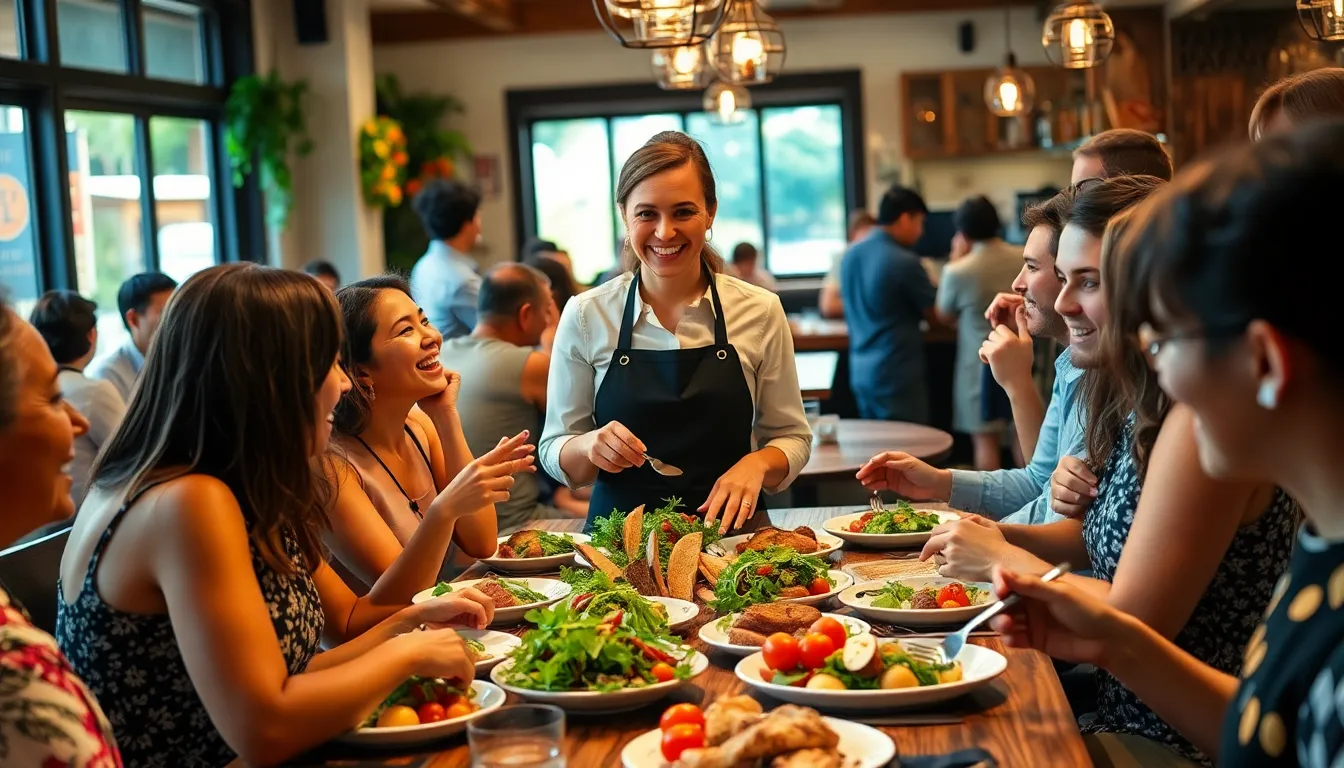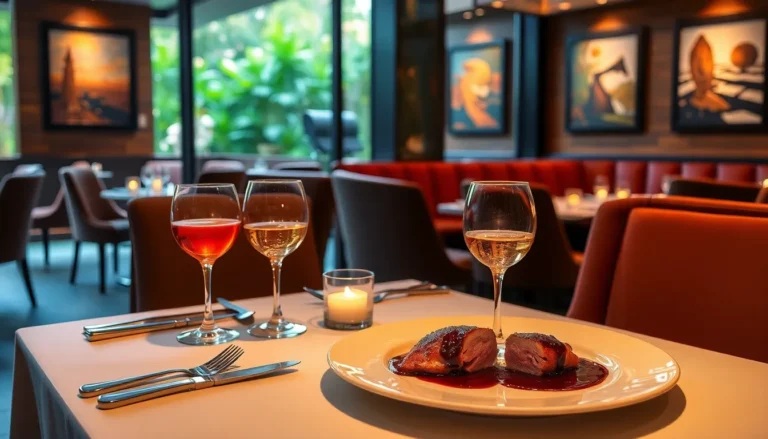Table of Contents
ToggleIn a world overflowing with fast food chains and cookie-cutter restaurants, authentic dining stands out like a diamond in a sea of rhinestones. It’s not just about filling your belly; it’s an experience that tantalizes the taste buds and nourishes the soul. Imagine savoring a dish that’s been crafted with love, tradition, and a sprinkle of family secrets—now that’s a meal worth writing home about!
What Is Authentic Dining?
Authentic dining refers to the experience of enjoying meals that truly represent a culture’s culinary heritage. It centers on locally sourced ingredients and traditional cooking methods, fostering a genuine connection to the food’s origin.
Authentic dining immerses individuals in the rich tapestry of flavors, aromas, and techniques that define a particular cuisine. Dishes showcase unique recipes passed down through generations, with each meal telling a story of its cultural roots.
Restaurants specializing in authentic dining often prioritize quality over quantity, carefully curating their menus to reflect local traditions. Patrons experience not just the taste but also the ambiance that complements the meal, enhancing the overall experience.
Community plays a vital role in authentic dining. Chefs often interact with guests, sharing insights into their culinary journey, which adds a personal touch to the experience. Enjoying a meal in this setting fosters a deeper appreciation for the effort behind each dish.
Dining authentically creates lasting memories, as meals are not merely consumed but savored. Every bite reflects the passion of those who prepare it, leading to an enriched dining experience that fast food cannot replicate.
Ultimately, authentic dining transcends food; it connects diners to the culture, ingredients, and traditions that shape their meals.
Key Features of Authentic Dining

Authentic dining embodies a commitment to high-quality, culturally rich food experiences. This concept revolves around specific features that elevate meals beyond the ordinary.
Local Ingredients
Fresh, locally sourced ingredients are the foundation of authentic dining. Many restaurants cultivate relationships with farmers and local markets to ensure the highest quality produce, meats, and dairy. Seasonal availability plays a crucial role in menu design, reflecting regional flavors. Dishes evolve based on what’s fresh, allowing chefs to showcase their creativity and connection to the locale. This emphasis on local sourcing fuels sustainability efforts, promoting community agriculture and reducing transportation emissions.
Traditional Cooking Techniques
Traditional cooking techniques underpin the authenticity of culinary experiences. Chefs favor methods passed down through generations, such as slow roasting, fermenting, or hand-rolling pasta. These practices highlight the skill and artistry involved in food preparation, showcasing the dedication behind each dish. A focus on time-honored methods preserves flavor and texture, enhancing the overall dining experience. Guests often witness these techniques firsthand, deepening their understanding and appreciation of the culture tied to their meal.
The Importance of Cultural Representation
Cultural representation within authentic dining enriches the culinary landscape by showcasing diverse heritage and traditions. This representation fosters an appreciation for unique flavors each culture brings to the dining table, facilitating a deeper understanding of various cuisines. Diners experience more than just flavors; they engage with history, stories, and customs tied to every dish.
Restaurateurs often highlight traditional cooking methods that reflect cultural narratives. Methods like grilling skewers or preparing fermented dishes serve as gateways to a culture’s past. Each bite embodies the essence of shared experiences, allowing diners to participate in narratives passed down through generations.
Locally sourced ingredients exemplify commitment to culture while supporting regional producers. Connecting with farmers enables chefs to craft menus that are authentic and seasonally inspired. Such partnerships strengthen local economies and highlight sustainability in dining practices.
Culinary authenticity thrives on the communal aspect of sharing meals. Cultures often emphasize gathering, transforming dining into a social experience filled with connection and conversation. Chefs frequently share their journeys, creating bonds with diners and engaging them in the cultural tapestry.
Attention to cultural representation cultivates respect for food traditions. Celebrating specific dishes, whether it’s a classic curry or a handmade tortilla, honors the meticulous efforts of those who craft them. This highlights not just flavors but also the cultural significance, elevating the overall experience.
Diners who embrace cultural representation in authentic dining often reflect on their experiences long after leaving the table. This lasting impact reinforces the importance of preserving culinary practices that are unique and meaningful. Ultimately, genuine cultural representation fosters an enriching dining experience embracing heritage and tradition.
Popular Authentic Dining Destinations
Exploring authentic dining destinations reveals a rich landscape of flavors and experiences. These locations highlight regional specialties and iconic restaurants that embody culinary traditions.
Regional Specialties
Distinct flavors characterize authentic dining experiences across various regions. In Mexico, savor traditional mole and fresh tacos crafted from local ingredients. Italy boasts handmade pasta dishes incorporating regional herbs and vegetables. Thai cuisine shines with vibrant curries and aromatic soups that reflect the country’s rich agricultural heritage. India features spices cultivated in the region, showcased in dishes like biryani and dosa. Locally sourced foods enhance these specialties, allowing diners to connect with the environment and cultural heritage behind each meal.
Iconic Restaurants
Renowned restaurants often serve as embodiments of authentic dining. New York City’s Katz’s Delicatessen delights with its pastrami sandwiches, a recipe dating back over a century. In Tokyo, Sukiyabashi Jiro presents sushi crafted with meticulous precision and the freshest fish available. Paris’s Le Meurice highlights classic French cuisine with an emphasis on seasonal produce, appealing to both locals and tourists. Each establishment tells its own story through innovative interpretations of traditional dishes. Diners experience the passion that drives chefs to honor their culinary roots in unique and unforgettable ways.
Embracing authentic dining opens the door to a world of culinary exploration and cultural appreciation. It’s not just about the food but the stories and traditions that accompany each dish. Diners are invited to savor meals that connect them to the heritage and artistry behind the cuisine.
By choosing restaurants that prioritize quality and cultural representation, individuals can support local economies while enjoying a richer dining experience. Authentic dining fosters community and conversation, transforming meals into memorable gatherings.
As the culinary landscape continues to evolve, the value of authentic dining remains steadfast, reminding everyone of the joy found in genuine flavors and shared experiences.








